2 dB over a dipole in the directions that are perpendicular to the plane of the loop. The azimuth patterns formed by these antennas are similar to the figure-8 pattern of the dipole. Three versions are shown: the square loop (Fig. 14-3), the diamond loop (Fig. 14-4), and the delta loop (a.k.a. D-loop and triangle—Fig. 14-5). The square and diamond loops are built with /4 on each side, and the delta loop is /3 on each side. The overall length of wire needed to build these antennas is
The polarization of the three loop antennas is horizontal, because of the location of the feedpoints. On the square loop, moving the feedpoint to the middle of either vertical side will provide vertical polarization. Similarly, on the diamond loop vertical polarization is realized by moving the feedpoint to either of the two adjacent apexes. On the delta loop, placing the feedpoint at either of the two other apexes produces a diagonal polarization that offers approximately equal vertical and horizontal polarization components.
The feedpoint impedance of the 1 loop is around 100 Ω, so it provides a slight mismatch to 75-Ωcoax and a 2:1 mismatch to 52-Ωcoax. A very good match to 52-Ω coax can be produced using the scheme of Fig. 14-6. Here, a quarter-wavelength coaxial cable matching section is made of 75-Ω coaxial cable. The length of this cable should be
From Book : Practical Antenna Handbook - By Joseph J. Carr





No comments:
Post a Comment